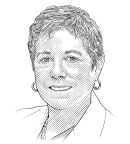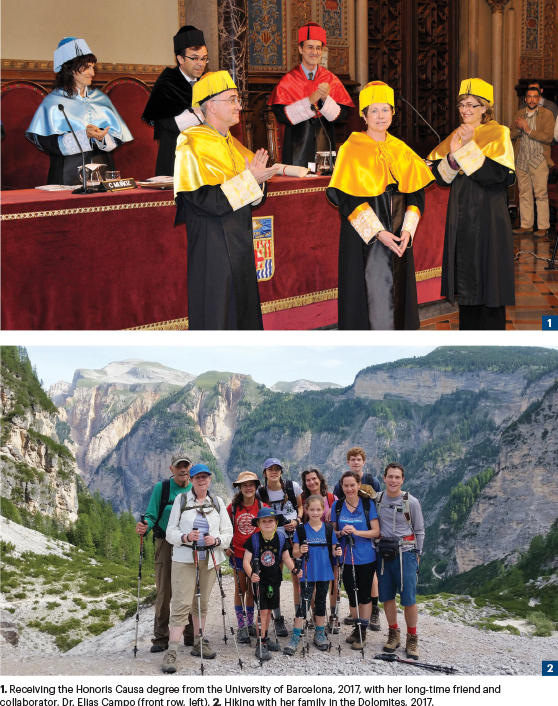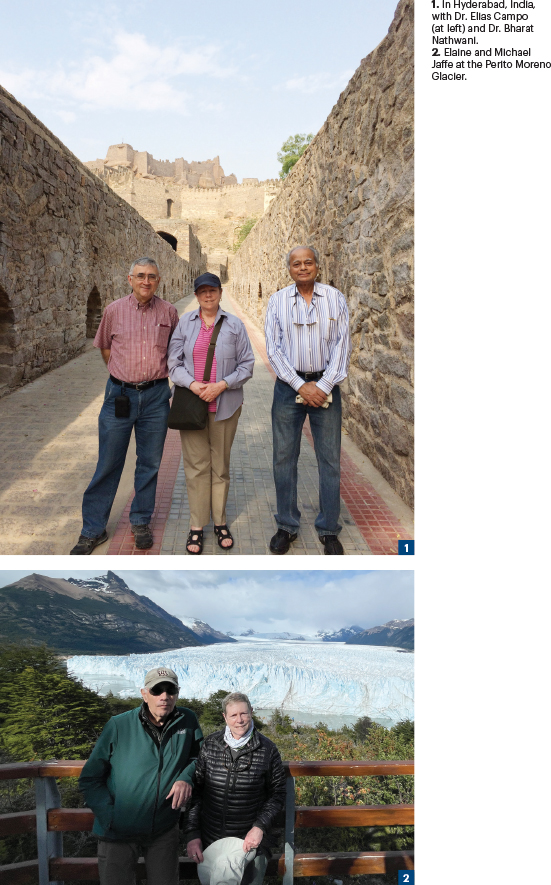In the era of genomics and precision medicine, the role of pathology in diagnosis and cancer management is rapidly evolving. For the past 50 years, from her office at the Center for Cancer Research, National Cancer Institute (NCI), pathologist Elaine S. Jaffe, MD, has been at the forefront of that evolution, pioneering studies related to the classification of malignant lymphomas that led an international effort for consensus among clinicians and pathologists. Her current work focuses on lymphomas as tumors of the immune system. Using a combination of immunophenotypic, genomic, and genetic approaches, her group is examining the pathogenesis of lymphomas, the mechanisms of transformation, and signaling pathways involved in control of cellular proliferation and differentiation.
An Immigrant’s Tale
Dr. Jaffe is the daughter of Russian Jews who fled the pogroms. “There were these little villages called shtetls; both my parents grew up in shtetls in the Ukraine, and the Cossacks would storm the village, with devastating consequences. My mother described to me an episode when she and her mother and her baby sister hid in the woods while the Cossacks came through and burned the town to the ground.
It wasn’t a pleasant environment, so along with a lot of other people, they emigrated to the United States. Dr. Jaffe continued: “This took several years in the case of my father’s family. My grandfather came over first with the eldest sister to establish a ‘beachhead,’ and my father was left behind as a teenager as the man of the family. He had five brothers and sisters, actually six (one died), and so I think that forced him to grow up fast.”
ELAINE S. JAFFE, MD

TITLE
Senior Investigator, Center for Cancer Research, National Cancer Institute, Bethesda, Maryland
MEDICAL DEGREE
MD, University of Pennsylvania School of Medicine, Philadelphia
ON HER DECISION TO BECOME A PATHOLOGIST
“I became interested in pathology during my second year at medical school. We had a pathology course, and looking through the microscope, I kind of saw medicine come alive. Seeing pathophysiology unveiled beneath the microscope made medicine exciting to me; I wanted to understand what caused disease and how these changes occurred in a patient.”
Dr. Jaffe’s father did not talk about what he had experienced in Russia as much as her mother did. “I think people deal with these things in different ways,” she said. “My grandfather came over before World War I, and then during the war, a lot of this immigration was interrupted, naturally. So, my father came over with the rest of the family after the war, and my mother came over about the same time.”
An Early Independent Streak
Dr. Jaffe continued: “When my mother arrived, as a 9-year-old, she was placed in first grade and did not know a word of English, but she rapidly progressed. She had an uncle who was born here, and he tutored her in English. She wound up speaking, I would say, the King’s English; she had no accent. My father was 16, and I think he briefly attended high school, but it was never clear to me how much schooling he had in this country. It was something he didn’t like to talk about, but I think both my parents were extremely intelligent. My mother was an avid reader and very interested in the arts, not so much science; no one in the family was a scientist.”
As a young girl, Dr. Jaffe developed a love for science, first as an amateur geologist, collecting rocks and searching for fossils. “Then, in high school, I took biology, and the science of living beings seemed more interesting than rocks and stones. I got more and more interested in biology and medicine and decided in high school that I was going to go to medical school. I never wavered from that decision,” she related.
According to Dr. Jaffe, her father’s independent spirit motivated her own road to self-expression. “My father was very much a self-made man. At 16, he went to work in the diamond business as an apprentice; in his early 20s, he started his own business, and that expanded. He started out in Brooklyn and then moved to the diamond district in Manhattan on 47th Street. He was a very strong personality, and I think he had more trouble with men than with women, so he encouraged both his daughters to excel in school,” said Dr. Jaffe.
An Interest in Biology
Dr. Jaffe started out at Cornell University in Ithaca, New York, ultimately completing her medical education at the University of Pennsylvania in Philadelphia. It was the early 1960s, and the feminist movement was just blooming on the national stage. Even so, women still rarely ventured into such male-dominated professions as medicine. “I was 1 of only 5 women in a class of more than 100 medical students.” she noted. “What drew me to medicine was interest in disease, in biology. I never had this Florence Nightingale fantasy of healing the sick. I didn’t go into medicine because I could help humanity; I went into it because I thought it was interesting to study.”
Asked about her decision to become a pathologist, Dr. Jaffe replied: “I became interested in pathology during my second year at medical school. We had a pathology course, and looking through the microscope, I kind of saw medicine come alive. I realized that by studying tissues, you could really understand what was happening to a patient. Seeing pathophysiology unveiled beneath the microscope made medicine exciting to me; I wanted to understand what caused disease and how these changes occurred in a patient.”
An Eye-Opening Stint at the NCI
During her second year at medical school, Dr. Jaffe met and married her husband, Michael Evan Jaffe, a lawyer-in-training. After he finished law school, he accepted a clerkship with a federal judge in the Federal District Court in Wilmington, Delaware, so Dr. Jaffe applied for a transfer from Cornell to the University of Pennsylvania.
“I wanted to do pathology, so I applied for pathology residencies,” she said. “My husband is originally from Texas. He was going to be finishing his clerkship and accepted a job with a firm in Washington, DC, and I applied for pathology residencies in DC and got a place at Georgetown.”
After a year at Georgetown, Dr. Jaffe entered an NCI residency program, as the world of cancer therapy was undergoing dramatic changes. In essence, curative chemotherapy was being born. “At the NCI, they were conducting acute lymphoblastic leukemia protocols in the pediatric oncology group. Remarkably, those patients were being cured, and there were long-standing remissions, completely changing the face of the disease,” Dr. Jaffe said. “Vince DeVita had developed the MOPP [mechlorethamine, vincristine, procarbazine, prednisone] chemotherapy regimen for Hodgkin lymphoma. For the first time, patients with this disease were being cured. So, there was a great deal of excitement about the possibility of a cure for lymphoma.”

Dr. Jaffe immersed herself in the robust research environment, and her early research at NCI helped replace purely descriptive classifications with those based on immunology, which, in turn, helped in the development process leading to today’s disease-specific therapies. It’s important to note, that at that time, researchers still didn’t know exactly which cells generated lymphomas. Dr. Jaffe and her fellow NCI researchers demonstrated that red blood cells coated with antibody and erythrocyte antibody complement (EAC) adhered to what they thought were B-cell areas.
Focusing on nodular lymphoma, Dr. Jaffe set out to prove her thesis. “I knew normal follicles had these complement receptors, so we thought we could prove that nodular lymphoma is derived from follicular B cells. And lo and behold, the red cells coated with EAC stuck to these B cells, proving they were lymphocytes derived from the lymphoid follicles,” she explained. Her groundbreaking research paper was published in TheNew England Journal of Medicine. “It became a citation classic, and I would say, it was a pioneering discovery at the time,” she added.
Classification of Lymphomas
In 1991, Dr. Jaffe and other internationally recognized pathologists were invited to attend the newly formed International Lymphoma Study Group, headed by Dr. Peter Isaacson. “He invited about 15 hematopathologists from around the world to that first meeting, all of the people regarded as experts. There were several of us from the United States, Germany, and France, and one person from Hong Kong, and he brought us together for 3 days. A number of these people I had never met before. Although we were all strangers to one another, we realized that we all spoke the same language and were all seeing the same things, and the political divisions of the past kind of dissipated,” said Dr. Jaffe.
The meeting synergized the classification initiative. “As we discussed lymphomas, we found consensus on most items. So, in 1994, we published the REAL classification, which was published in Blood, and became the most highly cited article in all clinical medicine over the next 10 years,” she noted.
Dr. Jaffe continued: “We were defining individual disease entities, and the clinicians embraced this. Our classification was then adopted by the World Health Organization, becoming the WHO classification. The development of the REAL and WHO classifications had a major impact on the field, and they are now a part of both the general practice of hematology/oncology and all clinical trials. They are the language of patient care and management and impact how patients are treated.”
Asked about her mentors, Dr. Jaffe responded: “My first mentor in hematopathology was Dr. Costan Berard, Head of Hematopathology when I started my residency and fellowship. In fact, I was his first fellow, and he kind of opened the door for me to develop my own career and initiated some of the collaborations with immunologists that led to our work. He was a very good mentor in that when some of the early results came out, and they were exciting, he insisted I go and present them. So, if there was a meeting, I was the one to go and present; he never tried to take credit for my work. I think there are some mentors who wouldn’t have done that.”
An Illustrious Career
A senior investigator at the NCI since 1974, Dr. Jaffe has served on the editorial boards of TheAmerican Journal of Pathology, The American Journal of Surgical Pathology, Blood, Cancer Research, and Modern Pathology. She served as President of the Society for Hematopathology and the United States and Canadian Academy of Pathology (USCAP). In 1993, Dr. Jaffe was elected a fellow of the American Association for the Advancement of Science (AAAS). In 2005, she was Chair of the Medical Sciences Section of AAAS.

In 2021, Dr. Jaffe received the NCI Director’s Award for Career Lifetime Achievement. In 2022, she received the inaugural AACR James Ewing–Thelma B. Dunn Award for Outstanding Achievement in Pathology in Cancer Research as well as the Department of Health and Human Services (DHHS) Career Achievement Award. The citation for her DHHS award noted: “Dr. Elaine S. Jaffe has changed the way in which the diagnosis of lymphoma is made on a worldwide basis, (1) revolutionizing the integration of traditional pathological methods with immunologic and genomic approaches; (2) harmonizing for the first time the diagnosis of lymphoma and leukemia internationally; and (3) describing multiple new disease entities that have resulted in changes to clinical practice and management for numerous patients.”
Just recently, in 2023, Dr. Jaffe received the Federation of American Societies for Experimental Biology Excellence in Science Lifetime Achievement Award.
Pathology Is Not for Everyone
According to Dr. Jaffe, one needs to be born with a certain aptitude to be successful in the demanding career of oncologic pathology. “I can tell the first month when I sit down with a resident whether he or she has got it or not. Unfortunately, I feel there are some people who may choose pathology not really knowing what it is, or not having tried it, and are not well suited to it. A colleague of mine told me that one question she always asks residency applicants is about their hobbies; if they like art or photography, for instance, she feels they are more likely to be good pathologists than if they have other orientations. I found that interesting and remarkably keen-sighted. Pathology is a great field, but it takes a special kind of person to dedicate a career to it.”
Dr. Jaffe continued: “You must have a memory for those images and need to have a visual memory. Some people will look down the microscope day after day after day and never get it. They just can’t capture those images. I enjoy educating not only pathologists but clinicians and helping them to understand pathology. Also, I think basic scientists will do a better job if they understand the diseases.”
What does a leader in cancer pathology do to decompress? “I love opera and love to cook. My husband and I are also avid art collectors. We buy art too, but our walls are running out of space!”

